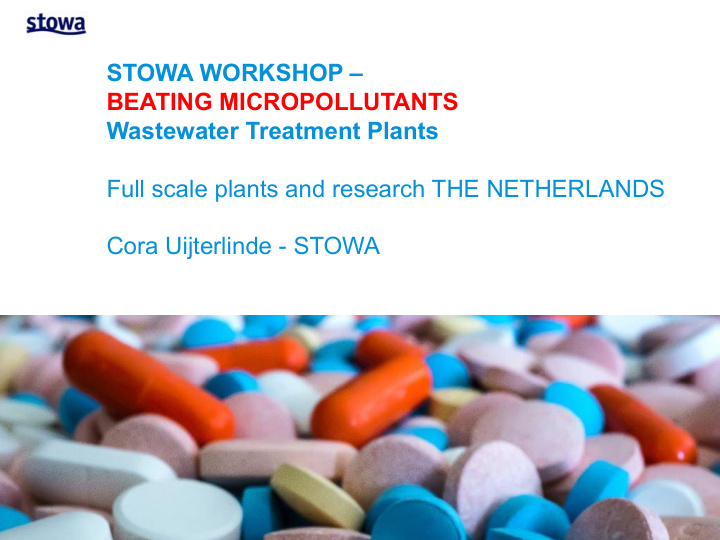



STOWA WORKSHOP – BEATING MICROPOLLUTANTS Wastewater Treatment Plants Full scale plants and research THE NETHERLANDS Cora Uijterlinde - STOWA
Research Report National Institute for Public Health and the • Environment: At least 140 tonnes pharmaceutical • residues emitted into surface water in the Netherlands Effects: • – Tissue damage – Endocrine disruption – Behavioural impacts Routing: 95% via normal use and • excretion by patients 10% emitted at hospitals and • care centres, 90% emitted at home
End-of-pipe measures 1.Implementing existing technologies in NL 2.Innovation programme 3.Supportive projects
Impact analysis micro pollutants surface water • 314 sewage treatment plants in NL • 2017: analysis of ‘hot spots’ • Impacts: – Increase of concentration – Watercourses affected – Drinking water intakes • ±100 STP’s need improvement?
Funding full scale projects • € 60mln for stimulating implementation • € 0,07/m3 (based on Dutch pilots & experiences in DE and CH) • Monitoring of guide substances • Biological effect monitoring • > 10 year in operation carbamazepine, propanolol, trimethoprim, metoprolol, benzotriazol, mengsel van 4- methylbenzotriazol / 5-methylbenzotriazol, hydrochloorthiazide, sulfamethoxazol, diclofenac, clarithromycine, sotalol
experiences – Visit Switzerland and Germany (2015) – Technology Overview (2017) – PACAS (2018) – Groote Lucht pilot ozone (2018) 0 7 / 1 1 / 2 0 1
Innovation programme micro-pollutants Hosted by STOWA • Funded by Ministry, STOWA and • regional water authorities ( € 11,7 mln during 5 years) Focus on: • – Treatment technologies on the threshold of breaking through – Optimisation of existing technologies – Technologies should have an added value compared to existing techniques (removal rates, costs, sustainability or eco-toxicological risks) Fundamental research in academic programme •
Goal innovation program implementing innovative technologies in 2025 on demo-scale (TRL 7)
Criteria innovation program 1) per treated m3 wastewater carbamazepine, propanolol, trimethoprim, metoprolol, benzotriazol, mengsel van 4-methylbenzotriazol / 5-methylbenzotriazol, hydrochloorthiazide, sulfamethoxazol, diclofenac, clarithromycine, sotalol
INNOVATION PROGRAM 2019 ozone with ceramic microfiltration ARVIA pretreatment and nanofiltration BAKF nanofiltration effluent O3-STEP Pharem - enzymes GRANULAIR FILTRATION CARBON zeolieten bio-activated carbon Usoniq ADSORPTION OXIDATION sandfiltration PAC4TOC cyclodextrine UV/H2O2 and ozone POWDER transformation / residues ACTIVATED CARBON PACAS + Fe PACAS Nereda Cloth filtration AC Effects on sludge treatment
NWO cec
Supportive projects › Harmonising analysing methods (incl. taking samples) › Biological effect monitoring › Knowledge exchange with neighbouring countries › research on micropollutants in rain weather flow and dry weather flow › developing tool for dimensioning hydraulic capacity
Knowledge exchange • Regional water authorities discuss experiences • Technical (performances of techniques) • Monitoring (what protocols) • Decision making process within organisation
Conclusions • Ready to beat micropollutants at WWTP • Implementation full scale • Boost in innovative technologies at WWTP
Recommend
More recommend